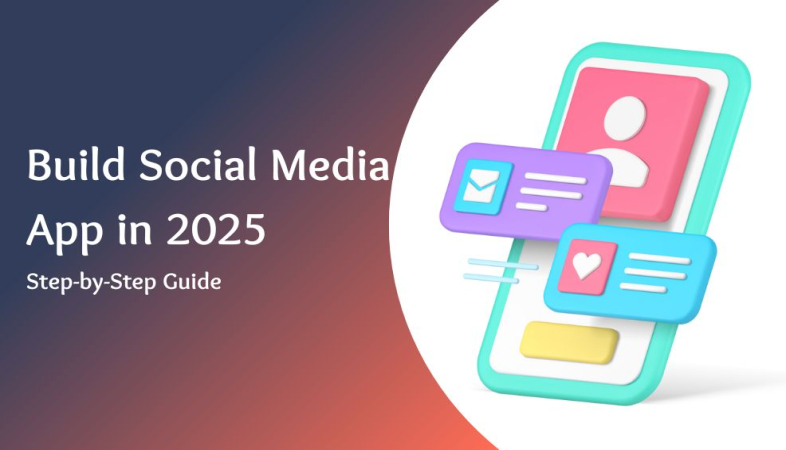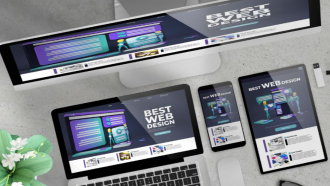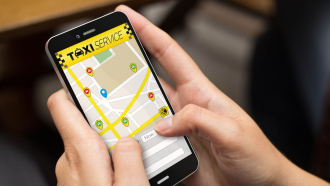
Step-by-Step Guide to Building a Social Media App in 2025

In 2025, social media isn’t just about staying connected – it’s how we interact with the world. From sharing real-time experiences to networking and collaborating on ideas, social platforms have evolved into essential digital ecosystems. If you've ever thought about creating your mobile social media app in Texas, this is the perfect time. But before you dive in, you'll need a clear roadmap.
Who Are You Building For?
Before you write a single line of code, you need to understand the current social media landscape. In 2025, users are looking for more personalized, authentic, and secure platforms. Generic platforms won't cut it anymore. Identify your target audience and determine what value your app will offer.
Questions to Ask:
-
Who is your app for? (Teens, professionals, creators, local communities?)
-
What gap does your app fill that others don’t?
-
Will it focus on video, audio, written content, or a mix?
Study emerging trends like micro-communities, Web3 integration, decentralized identity (DID), AI-powered content, and privacy-first models.
Define Key Features of Your App
After narrowing down your niche and identifying your target audience, the next step is to define your app’s key features. This foundation is crucial to delivering value to your users and building an experience that keeps them engaged. Start by focusing on the essential functionalities your app needs to work smoothly, then gradually expand to more advanced features that can set your app apart, especially as you prepare for future trends and innovations.
Core Features
These are the building blocks of most modern apps and should be prioritized during the initial development phase:
- User Authentication – Allow users to sign up and log in using email, phone numbers, or social media accounts.
- User Profiles and Avatars – Let users personalize their profiles to foster a sense of identity within your app.
- Newsfeed or Timeline – A dynamic content feed to showcase updates, posts, or media.
- Engagement Tools – Include options for likes, comments, and shares to promote interaction.
- Messaging System – Enable direct communication between users through chat or inbox features.
- Push Notifications – Keep users informed and engaged with real-time alerts and updates.
- Admin Panel – Provide moderators or administrators with tools to manage content and users efficiently.
Advanced Features (Future-Ready for 2025)
To stay competitive and ahead of the curve, consider integrating features that reflect current tech trends:
-
AI-Driven Content Suggestions – Use machine learning to recommend personalized content.
-
Augmented Reality Filters and 3D Avatars – Add a fun, immersive layer to user interaction.
-
Voice and Video Chat – Expand communication options beyond text.
-
Live Streaming – Allow creators or users to broadcast in real-time.
-
Blockchain Integration – Offer decentralized data storage or secure user authentication.
-
In-App Payments or Tipping – Monetize content and support creators with built-in payment features.
Defining these features early helps align your development roadmap with user expectations and future innovations.
Choosing the Right Tech Stack for Your App
Selecting the right technology stack is a crucial step in app development, as it directly influences your application’s performance, scalability, and long-term flexibility. A thoughtful choice ensures your app is efficient, responsive, and future-ready.
Frontend (User Interface)
For cross-platform development, frameworks like React Native and Flutter are highly popular due to their flexibility and speed. They allow you to build apps for both Android and iOS using a single codebase. However, if you're aiming for a native experience, you can opt for Swift for iOS development and Kotlin for Android.
Backend Development
A robust backend is the foundation of any app. Popular backend technologies include Node.js, Django, and Laravel, known for their reliability and developer-friendly features. For databases, you can go with Firebase or Firestore for real-time data handling, while PostgreSQL (SQL) and MongoDB (NoSQL) offer different structures based on your data needs.
Supporting Tools and Services
To support your infrastructure, cloud services like AWS and Google Cloud provide scalable hosting solutions. For live chat features, WebSocket or Socket.IO ensures real-time communication. For secure and smooth payment processing, integrating Stripe or PayPal SDKs is recommended. If you're looking to add intelligent features, AI APIs from OpenAI or Google AI can bring smart capabilities to your app.
In short, your tech stack is more than just tools—it’s the engine driving your app’s success. Choose wisely based on your app’s functionality and growth goals.
Design the UI and UX for Maximum Impact
An intuitive and engaging design is key to retaining users. A well-crafted user experience (UX) should feel effortless, fast, and enjoyable, while the user interface (UI) should be clean and responsive.
Steps to Follow
-
Sketch wireframes using tools like Figma or Adobe XD
-
Create user journeys to map interactions
-
Focus on simplicity, speed, and accessibility
UI/UX Trends for 2025
Stay current by incorporating dark mode with adaptive color schemes, gesture-based navigation for a fluid experience, and voice-driven interfaces for inclusivity. Personalization, powered by user behavior and preferences, is essential to create meaningful, user-first designs that elevate satisfaction and engagement.
Start with a Minimum Viable Product (MVP)
Instead of building a full-scale app right away, begin with a Minimum Viable Product (MVP) that includes only the essential features. This lean approach helps you validate your idea early and adapt based on real-world feedback.
Why Launch an MVP First?
-
Measure actual user interest and engagement
-
Gather valuable insights for improvement
-
Reduce development time and cost
Tips for Effective MVP Development:
Prioritize speed without sacrificing security. Utilize pre-built components and frameworks to accelerate progress. Roll out the MVP to a small group of beta users to test functionality and gather feedback before a wider launch. This approach ensures you build a product that users truly want.
Collaborate with a Trusted Development Partner
While having a great idea and strategy is important, working with the right development partner can make all the difference in bringing your social media app in Texas to life.
Ogrelogic, one of the best app development companies in Texas, has a strong track record of building scalable, user-friendly, and innovative mobile apps. With a deep understanding of the latest technologies, UX principles, and market trends, they offer end-to-end support — from strategy and design to development and deployment. Whether you're building a niche community platform or a feature-rich global social network, partnering with Ogrelogic ensures your project is in expert hands.
If you're serious about launching a social media app in 2025, consider teaming up with experts like Ogrelogic to turn your vision into a successful reality.
Test and Refine Your App
Thorough testing is essential to deliver a smooth, bug-free user experience. It helps identify issues early and ensures your app performs well across all scenarios.
Key Testing Methods
-
Unit Testing - Validates each feature or component individually
-
Integration Testing - Ensures different modules work seamlessly together
-
UI Testing - Confirms visual and interactive elements function properly on all devices
-
Beta Testing - Gathers real-world feedback from a small group of actual users
Collecting Feedback
Use in-app surveys, email forms, and monitor App Store reviews to gain insights. Listening to user feedback allows you to fine-tune the app, fix issues, and improve usability before launching to a wider audience.
Launch Your App with Impact
Once your app is polished and tested, it’s time to launch—but success lies in the strategy. A well-planned rollout boosts visibility and engagement from day one.
Steps to launch:
-
Publish your app on the Apple App Store and Google Play
-
Create compelling descriptions, screenshots, and demo videos
-
Integrate analytics tools like Firebase or Mixpanel for tracking
-
Design a clean landing page or microsite to capture interest
Promotional channels:
-
Leverage social media for targeted campaigns
-
Collaborate with influencers to reach your niche audience
-
Use PR efforts and press releases to gain coverage
-
Submit to platforms like Product Hunt and BetaList for early traction and exposure.
Monetize Your App Effectively
Monetizing your social app requires aligning your strategy with user expectations and your business goals. Choose a model that delivers value while generating revenue.
Top strategies include:
-
Freemium Model - Offer core features for free, with in-app purchases for extras.
-
Subscriptions - Charge users monthly or annually for premium tools and experiences.
-
Advertising - Integrate banner, native, or video ads to generate steady income.
-
Creator Tools - Enable tipping, fan memberships, or exclusive content for monetization.
-
Sponsored Content - Partner with brands for in-app promotions and collaborative opportunities.
The right mix ensures growth and profitability.
Scale and Optimize for Growth
As your app begins to attract users, it's time to focus on scaling and refining the experience. Prioritize stability, speed, and personalization to retain and grow your user base.
Technical optimization:
-
Utilize auto-scaling services from platforms like AWS or Google Cloud to handle increased traffic.
-
Optimize your database to ensure quick and reliable data access.
-
Fine-tune performance by reducing load times and compressing media assets.
-
Implement advanced analytics to deliver personalized content and experiences.
Boosting user growth:
-
Launch referral programs to encourage organic sharing.
-
Integrate gamification features like badges and rewards to increase engagement.
-
Host community-driven events and challenges to build loyalty and excitement.
Maintain and Evolve Your App
Launching your app is just the beginning—ongoing maintenance and evolution are essential to remain competitive and meet user expectations. Continuous monitoring and updates keep your app secure, engaging, and relevant.
Track and analyze:
-
Monitor user behavior, retention rates, and engagement trends.
-
Keep an eye on crash reports and bug logs to maintain stability.
-
Collect and evaluate user feedback and feature requests regularly.
Improve and update:
-
Roll out regular updates with fresh features and enhancements.
-
Quickly address bugs and respond to user complaints to build trust.
-
Ensure your app complies with security regulations like GDPR and CCPA by implementing necessary patches and protocols
Is 2025 the Year You Build the Next Big Social App?
Absolutely. The tools, technology, and user demand have never been more aligned for innovation. Whether you’re a startup founder or a business looking to expand into digital engagement, building a social media app in 2025 offers limitless potential.
But remember, success doesn’t come from just having a great idea. It comes from executing each step with intention, agility, and a commitment to your users. Follow this roadmap, stay adaptable to trends, and you'll be well on your way to launching a standout social platform that resonates in today’s competitive digital world.
Are you ready to start with your dream social app today? Let Ogrelogic help you with expert mobile app development in Texas and digital services! Contact us via email or by calling +1 (512) 861-8471 to start your journey today!








